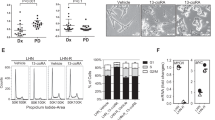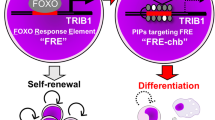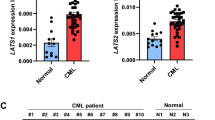Abstract
Chronic myeloid leukemia (CML) progresses from a chronic to a blastic phase where the leukemic cells are proliferative and undifferentiated. The CML is nowadays successfully treated with BCR-ABL kinase inhibitors as imatinib and dasatinib. In the CML-derived K562 cell line, low concentrations of imatinib induce proliferative arrest and erythroid differentiation. We found that imatinib upregulated the cell cycle inhibitor p27KIP1 (p27) in a time- and -concentration dependent manner, and that the extent of imatinib-mediated differentiation was severely decreased in cells with depleted p27. MYC (c-Myc) is a transcription factor frequently deregulated in human cancer. MYC is overexpressed in untreated CML and is associated to poor response to imatinib. Using K562 sublines with conditional MYC expression (induced by Zn2+ or activated by 4-hydroxy-tamoxifen) we show that MYC prevented the erythroid differentiation induced by imatinib and dasatinib. The differentiation inhibition is not due to increased proliferation of MYC-expressing clones or enhanced apoptosis of differentiated cells. As p27 overexpression is reported to induce erythroid differentiation in K562, we explored the effect of MYC on imatinib-dependent induction of p27. We show that MYC abrogated the imatinib-induced upregulation of p27 concomitantly with the differentiation inhibition, suggesting that MYC inhibits differentiation by antagonizing the imatinib-mediated upregulation of p27. This effect occurs mainly by p27 protein destabilization. This was in part due to MYC-dependent induction of SKP2, a component of the ubiquitin ligase complex that targets p27 for degradation. The results suggest that, although MYC deregulation does not directly confer resistance to imatinib, it might be a factor that contributes to progression of CML through the inhibition of differentiation.
This is a preview of subscription content, access via your institution
Access options
Subscribe to this journal
Receive 50 print issues and online access
$259.00 per year
only $5.18 per issue
Buy this article
- Purchase on Springer Link
- Instant access to full article PDF
Prices may be subject to local taxes which are calculated during checkout




Similar content being viewed by others
References
Dang CV, O’Donnell KA, Zeller KI, Nguyen T, Osthus RC, Li F . The c-Myc target gene network. Semin Cancer Biol 2006; 16: 253–264.
Eilers M, Eisenman RN . Myc’s broad reach. Genes Dev 2008; 22: 2755–2766.
Nesbit CE, Tersak JM, Prochownik EV . MYC oncogenes and human neoplastic disease. Oncogene 1999; 18: 3004–3016.
Vita M, Henriksson M . The Myc oncoprotein as a therapeutic target for human cancer. Semin Cancer Biol 2006; 16: 318–330.
Meyer N, Penn LZ . Reflecting on 25 years with MYC. Nat Rev Cancer 2008; 8: 976–990.
Leon J, Ferrandiz N, Acosta JC, Delgado MD . Inhibition of cell differentiation: a critical mechanism for MYC-mediated carcinogenesis? Cell Cycle 2009; 8: 1148–1157.
Polyak K, Lee MH, Erdjument-Bromage H, Koff A, Roberts JM, Tempst P et al. Cloning of p27Kip1, a cyclin-dependent kinase inhibitor and a potential mediator of extracellular antimitogenic signals. Cell 1994; 78: 59–66.
Coats S, Flanagan WM, Nourse J, Roberts JM . Requirement of p27Kip1 for restriction point control of the fibroblast cell cycle. Science 1996; 272: 877–880.
Chu IM, Hengst L, Slingerland JM . The Cdk inhibitor p27 in human cancer: prognostic potential and relevance to anticancer therapy. Nat Rev Cancer 2008; 8: 253–267.
Slingerland J, Pagano M . Regulation of the cdk inhibitor p27 and its deregulation in cancer. J Cell Physiol 2000; 183: 10–17.
Carrano AC, Eytan E, Hershko A, Pagano M . SKP2 is required for ubiquitin-mediated degradation of the CDK inhibitor p27. Nat Cell Biol 1999; 1: 193–199.
Sutterluty H, Chatelain E, Marti A, Wirbelauer C, Senften M, Muller U et al. p45SKP2 promotes p27Kip1 degradation and induces S phase in quiescent cells. Nat Cell Biol 1999; 1: 207–214.
Tsvetkov LM, Yeh KH, Lee SJ, Sun H, Zhang H . p27(Kip1) ubiquitination and degradation is regulated by the SCF(Skp2) complex through phosphorylated Thr187 in p27. Curr Biol 1999; 9: 661–664.
Bretones G, Acosta JC, Caraballo JM, Ferrandiz N, Gomez-Casares MT, Albajar M et al. SKP2 oncogene is a direct MYC target gene and MYC down-regulates p27(KIP1) through SKP2 in human leukemia cells. J Biol Chem 2011; 286: 9815–9825.
Faderl S, Talpaz M, Estrov Z, O’Brien S, Kurzrock R, Kantarjian HM . The biology of chronic myeloid leukemia. N Engl J Med 1999; 341: 164–172.
Melo JV, Barnes DJ . Chronic myeloid leukaemia as a model of disease evolution in human cancer. Nat Rev Cancer 2007; 7: 441–453.
Savona M, Talpaz M . Getting to the stem of chronic myeloid leukaemia. Nat Rev Cancer 2008; 8: 341–350.
Kavalerchik E, Goff D, Jamieson CH . Chronic myeloid leukemia stem cells. J Clin Oncol 2008; 26: 2911–2915.
Albajar M, Gomez-Casares MT, Llorca J, Mauleon I, Vaque JP, Acosta JC et al. MYC in chronic myeloid leukemia: induction of aberrant DNA synthesis and association with poor response to imatinib. Mol Cancer Res 2011; 9: 564–576.
Delgado MD, Lerga A, Canelles M, Gomez-Casares MT, Leon J . Differential regulation of Max and role of c-Myc during erythroid and myelomonocytic differentiation of K562 cells. Oncogene 1995; 10: 1659–1665.
Acosta JC, Ferrandiz N, Bretones G, Torrano V, Blanco R, Richard C et al. Myc inhibits p27-induced erythroid differentiation of leukemia cells by repressing erythroid master genes without reversing p27-mediated cell cycle arrest. Mol Cell Biol 2008; 28: 7286–7295.
O’Dwyer ME, Mauro MJ, Druker BJ . Recent advancements in the treatment of chronic myelogenous leukemia. Annu Rev Med 2002; 53: 369–381.
Ren R . Mechanisms of BCR-ABL in the pathogenesis of chronic myelogenous leukaemia. Nat Rev Cancer 2005; 5: 172–183.
Quintas-Cardama A, Cortes J . Molecular biology of bcr-abl1-positive chronic myeloid leukemia. Blood 2009; 113: 1619–1630.
Shah NP, Kasap C, Weier C, Balbas M, Nicoll JM, Bleickardt E et al. Transient potent BCR-ABL inhibition is sufficient to commit chronic myeloid leukemia cells irreversibly to apoptosis. Cancer Cell 2008; 14: 485–493.
Albajar M, Gutierrez P, Richard C, Rosa-Garrido M, Gomez-Casares MT, Steegmann JL et al. PU.1 expression is restored upon treatment of chronic myeloid leukemia patients. Cancer Lett 2008; 270: 328–336.
Munoz-Alonso MJ, Acosta JC, Richard C, Delgado MD, Sedivy J, Leon J . p21Cip1 and p27Kip1 induce distinct cell cycle effects and differentiation programs in myeloid leukemia cells. J Biol Chem 2005; 280: 18120–18129.
Gesbert F, Sellers WR, Signoretti S, Loda M, Griffin JD . BCR/ABL regulates expression of the cyclin-dependent kinase inhibitor p27Kip1 through the phosphatidylinositol 3-Kinase/AKT pathway. J Biol Chem 2000; 275: 39223–39230.
Jonuleit T, van der Kuip H, Miething C, Michels H, Hallek M, Duyster J et al. Bcr-Abl kinase down-regulates cyclin-dependent kinase inhibitor p27 in human and murine cell lines. Blood 2000; 96: 1933–1939.
Wu J, Meng F, Kong LY, Peng Z, Ying Y, Bornmann WG et al. Association between imatinib-resistant BCR-ABL mutation-negative leukemia and persistent activation of LYN kinase. J Natl Cancer Inst 2008; 100: 926–939.
Gomez-Casares MT, Delgado MD, Lerga A, Crespo P, Quincoces AF, Richard C et al. Down-regulation of c-myc gene is not obligatory for growth inhibition and differentiation of human myeloid leukemia cells. Leukemia 1993; 7: 1824–1833.
Lerga A, Crespo P, Berciano M, Delgado MD, Canelles M, Cales C et al. Regulation of c-Myc and Max in megakaryocytic and monocytic-macrophagic differentiation of K562 cells induced by protein kinase C modifiers: c- Myc is down-regulated but does not inhibit differentiation. Cell Growth Differ 1999; 10: 639–654.
Littlewood TD, Hancock DC, Danielian PS, Parker MG, Evan GI . A modified oestrogen receptor ligand-binding domain as an improved switch for the regulation of heterologous proteins. Nucleic Acids Res 1995; 23: 1686–1690.
Schenone S, Brullo C, Musumeci F, Botta M . Novel dual Src/Abl inhibitors for hematologic and solid malignancies. Expert Opin Investig Drugs 2011; 19: 931–945.
Kantarjian HM, Baccarani M, Jabbour E, Saglio G, Cortes JE . Second-generation tyrosine kinase inhibitors: the future of frontline CML therapy. Clin Cancer Res 2011; 17: 1674–1683.
Rubbi L, Titz B, Brown L, Galvan E, Komisopoulou E, Chen SS et al. Global phosphoproteomics reveals crosstalk between Bcr-Abl and negative feedback mechanisms controlling Src signaling. Sci Signal 2011; 4: ra18.
Chu I, Sun J, Arnaout A, Kahn H, Hanna W, Narod S et al. p27 phosphorylation by Src regulates inhibition of cyclin E-Cdk2. Cell 2007; 128: 281–294.
Nakayama K, Nagahama H, Minamishima YA, Miyake S, Ishida N, Hatakeyama S et al. Skp2-mediated degradation of p27 regulates progression into mitosis. Dev Cell 2004; 6: 661–672.
Kossatz U, Dietrich N, Zender L, Buer J, Manns MP, Malek NP . Skp2-dependent degradation of p27kip1 is essential for cell cycle progression. Genes Dev 2004; 18: 2602–2607.
Andreu EJ, Lledo E, Poch E, Ivorra C, Albero MP, Martinez-Climent JA et al. BCR-ABL induces the expression of Skp2 through the PI3K pathway to promote p27Kip1 degradation and proliferation of chronic myelogenous leukemia cells. Cancer Res 2005; 65: 3264–3272.
Chen JY, Wang MC, Hung WC . Transcriptional activation of Skp2 by BCR-ABL in K562 chronic myeloid leukemia cells. Leuk Res 2009; 33: 1520–1524.
Agarwal A, Bumm TG, Corbin AS, O’Hare T, Loriaux M, VanDyke J et al. Absence of SKP2 expression attenuates BCR-ABL-induced myeloproliferative disease. Blood 2008; 112: 1960–1970.
Hsieh FF, Barnett LA, Green WF, Freedman K, Matushansky I, Skoultchi AI et al. Cell cycle exit during terminal erythroid differentiation is associated with accumulation of p27(Kip1) and inactivation of cdk2 kinase. Blood 2000; 96: 2746–2754.
Rowley PT, Ohlsson-Wilhelm BM, Farley BA, LaBella S . Inducers of erythroid differentiation in K562 human leukemia cells. Exp Hematol 1981; 9: 32–37.
Roy S, Singh RP, Agarwal C, Siriwardana S, Sclafani R, Agarwal R . Downregulation of both p21/Cip1 and p27/Kip1 produces a more aggressive prostate cancer phenotype. Cell Cycle 2008; 7: 1828–1835.
Gomez-Casares MT, Vaque JP, Lemes A, Molero T, Delgado MD, Leon J . C-myc expression in cell lines derived from chronic myeloid leukemia. Haematologica 2004; 89: 241–243.
Lee TC, Ziff EB . Mxi1 is a repressor of the c-Myc promoter and reverses activation by USF. J Biol Chem 1999; 274: 595–606.
Acknowledgements
We thank Pilar Frade, María Aramburu and Guillermo Santana for technical assistance, Robert Eisenman, Theodore Lee and Robert Sclafani for constructs, and M Teresa Molero and Carlos Richard for useful comments on the manuscript. Funding for this work was provided by grants SAF11-23796 and ISCIII-RETIC RD06/0020/0017 to JL, FIS 11/00397 to MDD, SAF09-09254 and Fundación Mutua Madrileña to JMP, FIS08-0878 to SA and FIS08-0440 to JCC.
Author information
Authors and Affiliations
Corresponding author
Ethics declarations
Competing interests
The authors declare no conflict of interest.
Additional information
Supplementary Information accompanies the paper on the Oncogene website
Supplementary information
Rights and permissions
About this article
Cite this article
Gómez-Casares, M., García-Alegria, E., López-Jorge, C. et al. MYC antagonizes the differentiation induced by imatinib in chronic myeloid leukemia cells through downregulation of p27KIP1. Oncogene 32, 2239–2246 (2013). https://doi.org/10.1038/onc.2012.246
Received:
Revised:
Accepted:
Published:
Issue Date:
DOI: https://doi.org/10.1038/onc.2012.246
Keywords
This article is cited by
-
Cabozantinib promotes erythroid differentiation in K562 erythroleukemia cells through global changes in gene expression and JNK activation
Cancer Gene Therapy (2022)
-
Dual targeting of p53 and c-MYC selectively eliminates leukaemic stem cells
Nature (2016)
-
IRES inhibition induces terminal differentiation and synchronized death in triple-negative breast cancer and glioblastoma cells
Tumor Biology (2016)
-
Cks1 is a critical regulator of hematopoietic stem cell quiescence and cycling, operating upstream of Cdk inhibitors
Oncogene (2015)
-
MYC, a downstream target of BRD-NUT, is necessary and sufficient for the blockade of differentiation in NUT midline carcinoma
Oncogene (2014)



